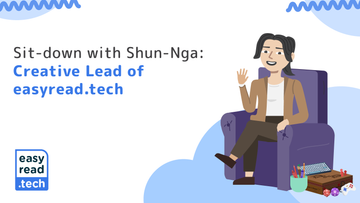Sit-down with Shun-Nga: Creative Lead of easyread.tech

Graphic by Justin Olivares.
Behind the easyread.tech team are some incredibly talented and passionate individuals, none more so than our very own Shun-Nga Hui.
Shun-Nga is a woman who wears many hats around the easyread.tech office, and is adored and appreciated greatly by the easyread.tech team and clients alike. I sat down with Shun-Nga to get to know the behind-the-scenes of a Creative Lead and the journey to get to where she is now, as well as her personal connection to our mission towards accessible information and communications for all.
So, Shun-Nga, please introduce yourself, and let us know a bit about who you are and what you do.
Hi! I’m Shun-Nga, and I’m a hearing-impaired Australian-Chinese with a penchant for creativity. I spend a lot of time making things happen behind the scenes, while wearing many hats - I’m a photographer, videographer, graphic designer, hair and makeup artist, and on occasion, you’ll find me writing documents for our clients and our organisation. I’m working on upskilling my animation and motion graphics skills as well, and I look after everyone and everything as best as I can!
What does your role as the Creative Lead at easyread.tech entail?
As the Creative Lead, I make sure that all of our work and our illustrations meet our quality standards, and support the team in translating documents into Easy Read and Plain English. When clients come to us, I’ll look after them and answer any questions they may have, and manage the project for them.
How did your personal experience as a hearing-impaired person influence your decision to work in the industry of accessible marketing and communications?
It’s a set requirement for me to have access to content and communications as someone with a disability that affects communication. I’m very privileged to have highly supportive parents, teachers and environments who helped me to become very competent in language and comprehension, and it’s a privilege not afforded to many of my peers with disability. I can speak up for myself, I’m capable of making media and content more accessible for others, and I want my peers to have increasingly better access to content, so it was very natural for me to get into the industry of accessible marketing and communications.
Why should people care about inclusive information?
I believe that everyone has a right to be included in society on the same level as everyone else, and a right to being informed. Non-inclusive information is otherwise discriminating against significant groups of people, not just on social, moral and ethical grounds, but also on economic grounds. On an emotional level, it’s also incredibly isolating and lonely to not be included as part of the community or society, and that loneliness is something everyone can work together to alleviate.
What are your top tips for an organisation that wants to make its information and communications more accessible to people with disabilities?
My top tip is to consider your information and communications from the perspective of a person with a disability. What information would they need or want to know? Can they read the information or have access to verbal versions of the information (low vision), can someone with a 5-yo or 7-yo English comprehension understand the content with or without help (intellectual disability), does the media have alternative written formats or captions (hearing impairment)? Asking yourself these questions can be a good place to start, and if you’re not sure about how accessible your information and communications are, you can ask us at easyread.tech for an expert opinion, or reach out to community groups who have lived experience with disability and accessibility.
How do you think implementing accessible practices in information and communications contributes to the overall reputation and brand perception of an organisation?
On a personal level, I’m much more likely to come back to certain organisations when I know that they’re going to have captions on every video they put out, or alternative ways of contacting them are valid because their emails are always checked, and I can expect an immediate or timely response. Every time I see a brand put out an ad that has subtitles, I’m much more likely to watch the ad, instead of skipping it straightaway.
Every time a business or organisation implements accessible practices, their reputation and brand perception goes up in the eyes of the community with lived experiences with disability. People with disabilities are three times as likely to avoid an organisation and twice as likely to dissuade others because of an organisation’s negative diversity reputation, but when content and communication are accessible, the response is overwhelmingly positive, leading to a significant rise in brand preference, purchase intent and peer recommendations. There is global research that shows that companies that champion disability inclusion achieve, on average 28% higher revenue, double the net income, and 30% higher economic profit margins compared to companies that do not prioritise disability inclusion (The Disability Inclusion Advantage).
With over a billion people globally having some form of disability, this is a significant audience that has a buying power of $13 trillion globally (Return on Disability).
What change would you like to see easyread.tech make in the wider accessible communications landscape?
I would love to see easyread.tech be a significant influence in making accessible communications the standard in Australia, across as many industries as possible. Australia is a multicultural country, with one in five of its people living with a disability, and there is always a place for accessibility regardless of where you go, in both the multicultural and communications landscape.
